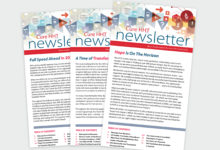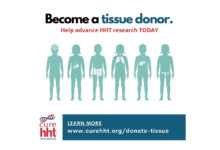What the HHT?
A blog for the HHT community
Posts by Riley Blevins
2022 Newsletters now available online!
Scan the pages of our printed 2022 newsletters (spring, summer and fall) as a pdf or Flipbook. Catch up on recent scientific news, progress, leadership changes and more.
Read MoreNewsletter Fall 2022
Back to School – Nosebleed Management
A message from Cure HHT Chief Medical Officer, Scott Olitsky, MD As children begin to return to school, now is a good time to talk to your school nurse and educators about HHT and nosebleeds. Nosebleed severity can vary widely among family members and it should always be remembered that the presence and/or severity of…
Read MoreDevelopment of HHT Centers of Excellence
In this newsletter, we have announced the addition of The University of Florida to the North American Centers of Excellence (CoE) team. This is great news for people with HHT living in Florida who have been looking forward to a place where they can be seen in their home state. While people in and near Florida will directly benefit from this addition, all of us with HHT will benefit indirectly as well. When a new center opens that means more physician experts are added to the HHT community. This increases our knowledge about how HHT affects people, what types of treatments are beneficial and enlarges the pool of potential clinical research sites to help us develop new tests, procedures and medications which may improve the lives of all people with HHT. It also boosts the number of medical personnel and trainees who learn about HHT that can later bring that knowledge with them when they see patients.
Read MoreBecome a Tissue Donor
Duke University, through a separate BVMC project, is collecting vascular malformations (VMs) associated with HHT to search for somatic mutations, possibly occurring in different genes than the ones already identified. All HHT patients undergoing surgery to remove an AVM from any organ (i.e., liver, lung, brain, skin, etc.), are encouraged to consider donating tissue. You do not need to have a brain AVM to participate in this study project.
Read More


